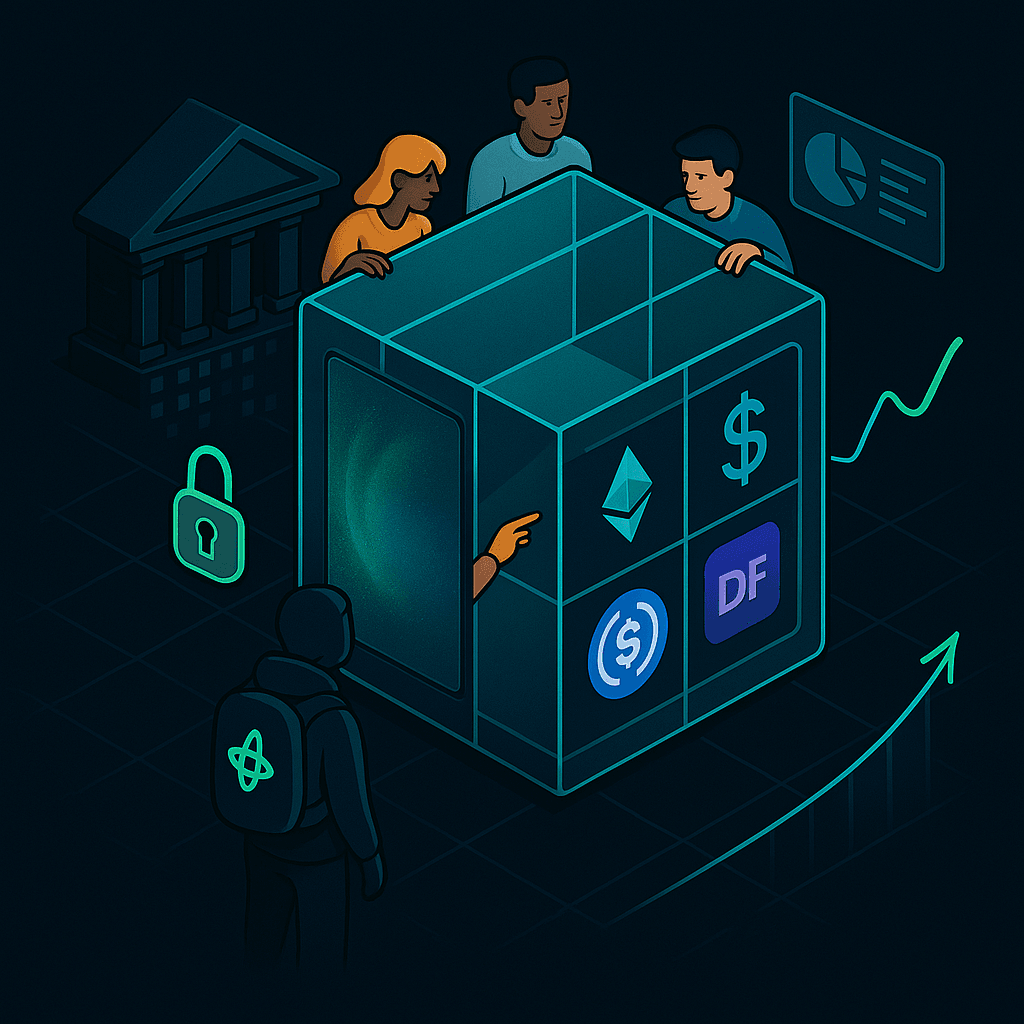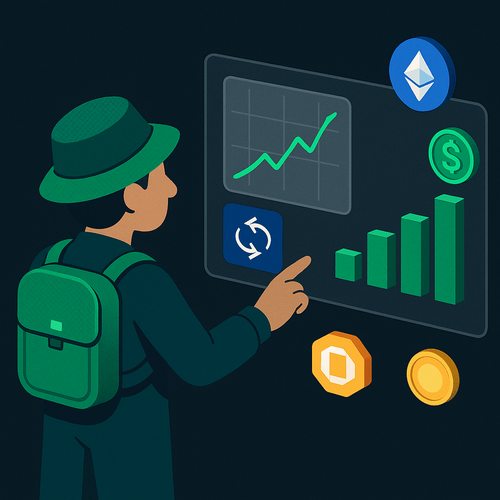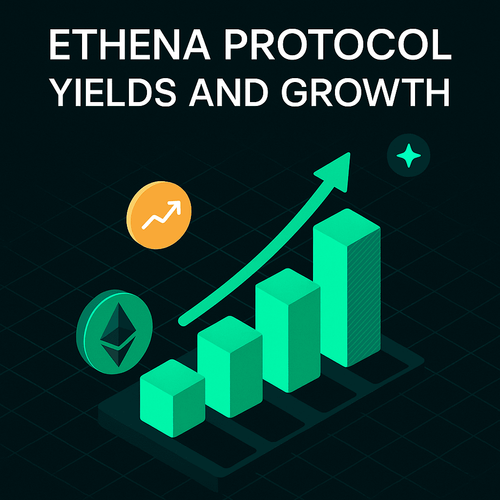A protocol that mimics a bank
InfiniFi introduces a familiar concept with an unfamiliar execution. It replicates the classic "borrow short, lend long" approach seen in traditional banking but does so through fully automated smart contracts. The core mechanism allows users to deposit stablecoins into the protocol and receive iUSD in return, a token pegged 1:1 to the US dollar. This is where the system branches.
Once a user holds iUSD, they can decide between two yield paths. Staking converts iUSD into siUSD, a liquid yield-bearing asset that offers lower risk and easy access to funds. Locking converts the deposit into liUSD, which is illiquid but offers significantly higher yield in exchange for a duration commitment. The differentiation creates an accessible structure where users select the level of risk and return they are comfortable with. It's a modern analog to tiered deposit accounts, with full on-chain visibility and flexibility.
Fractional reserve, programmatic yield
What happens after the deposit is where InfiniFi diverges from most DeFi protocols. The system doesn't sit passively on stablecoins. Instead, it allocates a fraction of capital, heavily favoring liUSD, and to a lesser extent siUSD into yield strategies. Protocols like Aave, Pendle, Fluid, and Ethena receive capital flows, while a portion remains in reserve to support redemptions and protect liquidity.
This reserve ratio is crucial as it allows siUSD holders to withdraw on demand while maximizing capital efficiency elsewhere. liUSD holders absorb more risk and receive higher returns. siUSD holders enjoy flexibility while still benefiting from boosted system performance. The logic is deeply hierarchical but transparent losses, if they occur, flow down an encoded waterfall. liUSD takes the first hit, then siUSD, and finally base iUSD. This structured downside protection mimics the senior-junior split seen in real-world banking and credit markets.
Yield and Points layered together
InfiniFi does not rely solely on yield to attract users. The platform introduced a Points program beginning June 1, 2025, designed to reward participation during its six-month launch phase. These Points accumulate through several vectors.
Depositing stablecoins and minting iUSD starts the process. Holding iUSD generates passive Points, with added multipliers for those who stake into siUSD or lock into liUSD. Liquidity provision is also incentivized. Adding iUSD to pools like iUSD/USDC on Curve not only strengthens ecosystem liquidity but unlocks more Points per dollar of LP capital. Users can also refer others to the protocol. If someone joins using your code, you receive a 10% bonus of their earned Points, adding a social layer to the incentive model.
These Points are not tradable, and no official token has been announced. However, many in the ecosystem speculate that they will eventually convert into governance rights or serve as the basis for a retroactive airdrop. It’s a familiar strategy across DeFi. Reward early behavior now, allow optionality later. In InfiniFi’s case, it ensures that users who actively contribute to the protocol’s growth have a stake in its future.
User Preferences
The appeal of InfiniFi varies depending on user preference. Those who prioritize safety and liquidity gravitate toward siUSD, earning modest but enhanced returns compared to standalone lending platforms. Those with a higher risk appetite opt for liUSD, accepting lockup in exchange for boosted APY. Power users and speculators may participate primarily to accumulate Points, anticipating future token distribution. In doing so, they still contribute capital and liquidity, indirectly supporting the protocol’s economics.
The yield dynamics reward all sides. Even cautious users receive better returns than traditional DeFi, thanks to the system’s reserve-based amplification. Bold users receive even more, compensating for liquidity tradeoffs and risk exposure. The key difference lies in the protocol’s internal alignment. Users aren’t just placing capital, they’re contributing to a coordinated model designed to extract more from the same base assets.
The broader vision
While the stablecoin yield engine is the current focus, InfiniFi’s long-term ambitions point toward a wider role in DeFi and beyond. The team has expressed interest in integrating tokenized real-world assets, such as government bonds or credit instruments. The logic is compelling. A 5% bond becomes more attractive if InfiniFi can turn it into 5.5% or 6% via fractional deployment. This type of refinancing could unlock new liquidity paths for real-world yield-bearing assets, drawing in users who might otherwise avoid DeFi due to volatility or complexity.
Additional roadmap items include broader protocol integrations, cross-chain deployments, and potential Layer 2 expansion. Governance is another likely evolution. While no token is currently live, the Points campaign signals a potential transition point. It’s plausible that InfiniFi introduces a governance layer once the initial program ends, using Point balances to seed voting rights or protocol revenue sharing.
Yield comparison
As of June 2025, InfiniFi offers stablecoin depositors two distinct yield options. The liquid tranche, siUSD, provides approximately 8% APY and allows deposits to remain fully liquid and redeemable at any time, catering to depositors who prioritize flexibility. Alternatively, the locked tranche, liUSD, offers higher yields ranging from 11.8% to 13.4% APY, accompanied by lock-up periods of approximately six weeks.
Summer Finance provides yields through fully liquid vaults without lockup restrictions. The USDC Vault offers around 5–6% APY, while the USDT Vault provides approximately 4–5% APY.
Morpho offers yields between 0.5% and 18% APY, benefiting from optimized lending pools and token incentives, and maintains full liquidity for deposits.
Pendle provides fixed yields ranging from 1% to 16%, locked until maturity. Investors selecting Pendle accept temporary illiquidity for the benefit of guaranteed returns.
Ethena (sUSDe) currently yields 4% derived from ETH-staking strategies, with a withdrawal notice period of approximately seven days.
Simply infiniFi
InfiniFi doesn’t market itself as speculative infrastructure. Its core pitch is functionality: stablecoin holders earn better returns by participating in a reserve-based model that mirrors real financial systems. The Points program is temporary acceleration, not the foundation. The real foundation is an incentive structure aligning risk, transparency, and upside in a way that outperforms siloed strategies.
The value is not just in the APY but in how that APY is generated, distributed, and governed. InfiniFi makes those mechanics legible. It turns passive capital into coordinated economic behavior, and simple deposits into something more strategic.




